
In the ever-growing list of memorable movie catchphrases, “I tawt I taw a puddy tat” is undoubtedly near the top. First uttered in 1942 by a seemingly innocent little bird with a large head that audiences would come to know as Tweety, the phrase would become one of the most mimicked in film history.
This year, Tweety celebrates his 80th anniversary, making his debut in the short subject, A Tale of Two Kitties, directed by Bob Clampett. Known in-house as “Orson”, he faces off against a pair of felines named Babbit and Catsello (cat caricatures of Abbott and Costello) and first utters the now-famous “puddy tat” line.
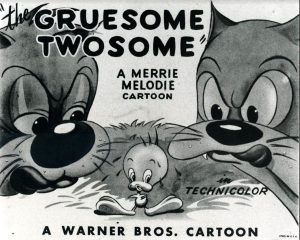 Clampett told author and animation historian Mike Barrier that he based that the first design of Tweety was based on the director’s baby picture.
Clampett told author and animation historian Mike Barrier that he based that the first design of Tweety was based on the director’s baby picture.
The beloved bird was referred to as Tweety in 1944’s Birdy and the Beast (also directed by Clampett). Here we see that Tweety’s not that innocent, as he passively tortures and outwits a cat throughout the short. At the conclusion, as the cat inadvertently grabs a grenade and disappears in an explosion, Tweety observes, “Ya know, I lose more putty tats that way!”
Tweety once again squares off against a pair of cats (one of which is a caricature of Jimmy Durante) in A Gruesome Twosome (1945). In this short, Tweety ratchets up his malevolence and, at one point, hits the cats with a sledgehammer. After they fall to the ground, Tweety notes, “Aw, the poor putty tats! They faw down and go boom!”
The year after the release of Gruesome Twosome, it would prove to be a landmark for Tweety and Warner Bros. animation. In Friz Freleng’s Tweetie Pie (1947), Tweety was paired for the first time with the character who would become his ongoing antagonist, Sylvester, the cat.
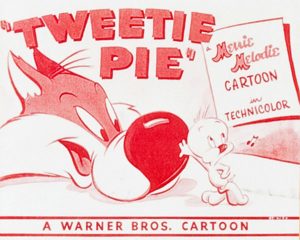 The combination of these two personalities proved irresistible, and the short would win an Oscar. In it, Sylvester (called Thomas here) has a master who takes pity on poor Tweety and brings the little bird into the house in a cage, while Sylvester/Thomas attempts to get the bird. Tweety uses everything from a blowtorch to a bowling ball to ward off the cat.
The combination of these two personalities proved irresistible, and the short would win an Oscar. In it, Sylvester (called Thomas here) has a master who takes pity on poor Tweety and brings the little bird into the house in a cage, while Sylvester/Thomas attempts to get the bird. Tweety uses everything from a blowtorch to a bowling ball to ward off the cat.
As author Steve Schneider writes in his book, That’s All Folks: The Art of Warner Bros. Animation: “Like Rodgers and Hammerstein, Tweety and Sylvester had enjoyed accomplished solo careers before they worked together. But it was only when they were paired that they reached the most rarefied levels of cultural achievement.”
Some of the highlights of their many appearances together include I Taw a Putty Tat (1948), another short with the “model” of Tweety in a cage, and Sylvester attempting to get him out of the cage and into his mouth. Canary Row (1950) brought in Granny as Tweety’s owner (another foil for Sylvester). Catty Cornered in 1953 has the two involved with two hysterical gangsters, and 1957’s Birds Anonymous (another Oscar winner) is a clever comedy about Sylvester attempting to stop eating Tweety by going, you’ll excuse the expression, “cold turkey.” In 1960, Hyde and Tweet, where Tweety inadvertently eats Dr. Jekyll’s formula and turns into a large, Dr. Hyde version of himself (brought to life with some creative character design).

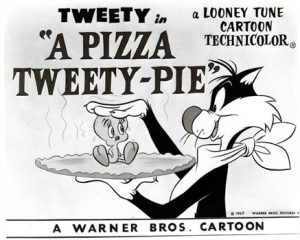
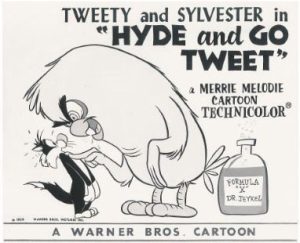
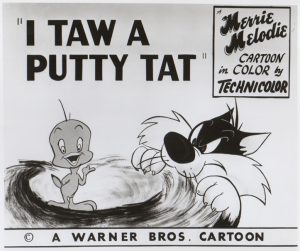
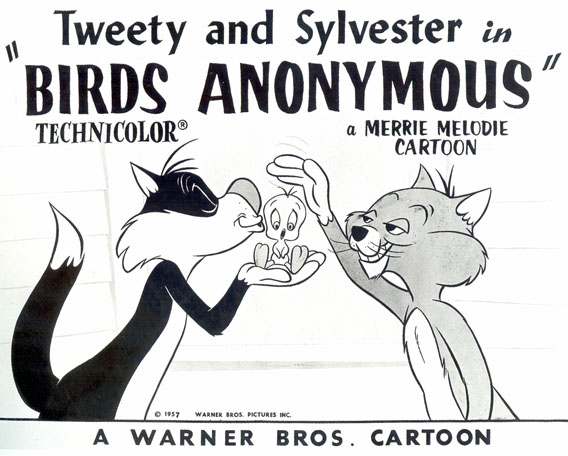
Tweety has remained an audience favorite with his innocence and a very knowing instinct. In the past three decades, he has been a part of appearances in 1988’s Who Framed Roger Rabbit (in a memorable moment with Eddie Valiant/Bob Hoskins), Space Jam (1996), and Looney Tunes: Back in Action.
In 1995, Tweety returned with the TV show The Sylvester and Tweety Mysteries, in which they were partnered with Granny and Hector the dog, solving mysteries around the world.
Through it all, Tweety has become one of the most popular and beloved characters in Warner Bros’ canon and for eight decades of seeing a “putty tat,” a little bird has provided tremendous entertainment.


 Michael Lyons is a freelance writer, specializing in film, television, and pop culture. He is the author of the book, Drawn to Greatness: Disney’s Animation Renaissance, which chronicles the amazing growth at the Disney animation studio in the 1990s. In addition to Animation Scoop and Cartoon Research, he has contributed to Remind Magazine, Cinefantastique, Animation World Network and Disney Magazine. He also writes a blog, Screen Saver: A Retro Review of TV Shows and Movies of Yesteryear and his interviews with a number of animation legends have been featured in several volumes of the books, Walt’s People. You can visit Michael’s web site Words From Lyons at:
Michael Lyons is a freelance writer, specializing in film, television, and pop culture. He is the author of the book, Drawn to Greatness: Disney’s Animation Renaissance, which chronicles the amazing growth at the Disney animation studio in the 1990s. In addition to Animation Scoop and Cartoon Research, he has contributed to Remind Magazine, Cinefantastique, Animation World Network and Disney Magazine. He also writes a blog, Screen Saver: A Retro Review of TV Shows and Movies of Yesteryear and his interviews with a number of animation legends have been featured in several volumes of the books, Walt’s People. You can visit Michael’s web site Words From Lyons at: 






















Well, I’ll be darned! I thought Robert Clampett used the name “Orson” for Tweety throughout. I thought it was Freleng who changed his name to Tweety.
(MAYBE I should watch “Birdy and the Beast”!)
From the famous book “Looney Tunes and Merrie Melodies,” p. 130: In a spot gag cartoon by Clampett entitled “Wacky Blackout,” released earlier in 1942, there is an early, sickly-looking version of Tweety who says he wants to be a dive bomber.
(And when Tweety sets his mind to something…)
Here’s as good a place as any to ask you folks a question about Sylvester:
As best I can tell, – an interesting irony here – the Warners cartoon director (of the ones who worked at Warners throughout the 1950s) who used Sylvester the least… gave Sylvester his name:
Charles M. Jones – in the 1948 cartoon “Scaredy Cat,” with Sylvester and Porky Pig.
Is that right? As noted above, Granny called Sylvester “Thomas” in the first Sylvester-Tweety cartoon (“Tweetie Pie,” 1947). Porky definitely calls him Sylvester in “Scaredy Cat.”
[That’s the first of four cartoons I think of as the “Clueless Porky Quartet:” “Scaredy Cat” (1948), “The Wearing of the Grin” (1951; no Sylvester in that one), “Claws for Alarm” (1954), and “Jumpin’ Jupiter” (1955).]
Note: Tweety was loaned out exactly _once_ to another director: He appears in Jones’s “No Barking” (1954), the third and last of the Claude Cat – Frisky Puppy cartoons. He tawt he taw a putty tat.
(Tweety also has a cameo in “Curtain Razor,” 1949, with Porky, but that’s a Freleng cartoon.)
Any enlightenment you folks can give me about Sylvester’s name – am I right about Jones naming him? – would be appreciated.
I have long acknowledged that it was Chuck Jones who christened that cat with the name “Sylvester” in Scaredy Cat. I first mentioned it on page 44 of my 1991 book about Tweety and Sylvester, I Tawt I Taw a Putty Tat.
Am I totally confused, or hadn’t Blanc used the same voice for a human character named Sylvester in some of his 1940s radio appearances (the Judy Canova show, maybe)? I assumed they chose that name for the cat because it was already identified with that name.
I’m not enough of an OTR buff to know the names of all the characters Mel Blanc played on radio – all I know is the Cat in question received the appellation in Jones’ Scaredy Cat, and there it stuck.
It was already established in an earlier CR article that Blanc based the voice on his limo driver, who apparently had a noticeable speech impediment.
One cameo never acknowledged was in Baby Bottleneck, on the baby assembly line. This was Clampett’s last animated use of him!
Then, after that, a few years ago part of the storyboard for Clampett’s next Tweety, pairing him with Sylvester (called “Fat Rat and the Stupid Cat”) finally surfaced, in an auction. (Still neve heard who got it, or how to find out, and you don’t really get the gist of the story from the six panels shown, so it’s totally mysterious).
A lot of people assume the project simply became Tweetie Pie, but that was actually a totally separate project that was originally supposed to have the woodpecker from the second Sylvester film.
When it comes to cartoon characters in yellow who are celebrating their 80th anniversary this year, as far as I’m concerned it’s Mighty Mouse first and all others last. I appreciate Friz Freleng’s superb comic timing as much as anyone, but baby talk gets on my nerves.
Michael, your posts are always a pleasure to read because of your enthusiasm for the subject matter and your unfailingly positive attitude. But it’s an axiom of film criticism that negative reviews are far more fun to write than positive ones; this is the universe’s way of compensating critics for having to sit through so many terrible movies. So maybe one of these days, just for variety’s sake, you might treat us to an anniversary profile of a cartoon that you really dislike. No holds barred, just come out swinging and don’t pull any punches. If you singled out the voice cast for special opprobrium, you could call it “Animation Cast-igation”!
“Michael, your posts are always a pleasure to read because of your enthusiasm for the subject matter and your unfailingly positive attitude. But it’s an axiom of film criticism that negative reviews are far more fun to write than positive ones; this is the universe’s way of compensating critics for having to sit through so many terrible movies. So maybe one of these days, just for variety’s sake, you might treat us to an anniversary profile of a cartoon that you really dislike. No holds barred, just come out swinging and don’t pull any punches. If you singled out the voice cast for special opprobrium, you could call it “Animation Cast-igation”!”
Yeah, I disagree there. I think Youtube ruined the enjoyment of negative reviews for the most part (and I’m tempted to name names).
Hi Paul, I will use my “unfailing optimism” to say thank you!:). I appreciate your kind words and support of Mighty Mouse. I love him, as well.
While I do agree that it’s sometimes just as fun (if not more so) to critique something you’re just “not a fan of” (and I’ve written my share of unfavorable reviews through the years), I truly enjoy focusing on the positive.
The opposing camp of negativity seems to fill so much of our world that I prefer not to add to it and join in.
I laughed out loud at the thought of “Castigation,” :D, but I think I think I will stick to celebrations. They mean so much more to me.
Thanks for this, and your other notes, and for reading my work!
I had a feeling you’d remain true to the dictum of Thumper’s father. Fair enough! Keep accentuating the positive, and don’t mess with Mister In-Between whatever you do! That guy is psycho!
My favorite S&T cartoons:
-Canary Row
-Putty Tat Trouble
-Room and Bird
-Gift Wrapped
-A Bird in a Guilty Cage
-Satan’s Waitin’
-Red Riding Hoodwinked
-Tweet and Sour
-Tree Cornered Tweety
-Birds Anonymous
-Greedy For Tweety
-Tweet and Lovely
-Hyde and Go Tweet
-The Last Hungry Cat
Man, did they have a good filmography. It’s easy to take for granted because you think, “Oh they’re just a bunch of spot gags”, but really, there are very few outright duds.
Actually, Warners has been celebrating Tweety’s 80th birthday with some merch at their online store and the DVD/streaming movie “King Tweety” (which has some highly questionable character designs).
If Warners _really_ wanted to celebrate Tweety’s 80th birthday properly, they’d release all the (remaining) Tweety-Sylvester cartoons (1947-64) on DVD…
By the way… Thank you, Mr. Beck, for answering my question about Sylvester. (I’ve been thinking about getting your Sylvester-Tweety book. You gave me a GOOD excuse.)
I want to pick on you about something, though! Somewhere in this Web site, you identify Tweety as a canary. No, he isn’t! According to the newsman in “Catty Cornered” (1953), he is a rare Tweety Bird!
“I’m a tweet witto bird in a giwded cage,
Tweety’s my name but I don’t know my age…”
(For the rest of that, see “All A-Bir-r-r-d,” 1950.)
According to Friz Freleng, in an interview I did with him for that book, Tweety is a canary. I always remember him telling me – “Tweety doesn’t look like a canary – or any bird you’ve ever seen. He’s a canary because we say he’s a canary. And the audience accepts that.”
Which, as I understand it, was because of objections by the Hays Office to the original look of Tweety being “naked,” hence risking the Moral Corruption of Children.
I wonder when June Foray starts the voice of Granny, 1953 or 1955?
1955 releases (though they were probably recorded in 1953). Happy to let Keith Scott correct me, but I believe June’s first “Granny” is in 1955’s This Is A Life? and later that year in Red Riding Hoodwinked.
The cinema where I work had a DVD collection, Looney Tunes Spotlight Vol. 2, which we used occasioally when hosting private birthday parties for kids. Eventually I felt compelled to write “DO NOT USE” in black Sharpie on the first disc of the set – it led off with nine Tweety cartoons in a row, and nothing kills funtime (especially for the adults in the room) like Too Much Tweety! What starts out charming becomes very irritating very quickly, and Tweety’s delivery will have that effect on you.
If it had been Bugs, no problem. But this was a terrible programming decision.
I will agree with you on one thing – watching nine Tweety cartoons back to back is NOT a good idea!
To be fair, the DVD collections were never designed to be run in a theater setting. For fans collecting these shorts, though, it was a wonderful programming decision.
Tweety cartoons are taken for granted usually. Many are brilliant, like Satan’s Waitin’.
Watching nine cartoons in a row featuring the same character is not a good idea, regardless of who the character is. I proved that by trying to watch a whole bunch of Road Runner cartoons in a row. (Maybe Bugs is an exception to the rule.) They were never meant to be watched that way.
I’ve spent many decades screening cartoons in every configuration – for the public, NEVER run nine (or twelve or any amount) of the same character’s films in a row. For the love of God, never run nine Terrytoons in a row; never run nine Chuck Jones or Tex Avery in a row. In fact the ONLY director you CAN run nine in a row is Bob Clampett. I’ve done it. Clampett doesn’t wear the audience out (as you might think).
Mix it up – always think “variety”. My current shows at the New Beverly work really well when we show a Looney Tunes, next to a Noveltoon, followed by an Avery, then a Terrytoon, then a Disney… I’ve gotten incredible reaction to Paul Smith 1960s Woody cartoons when they are sandwiched between a Tom & Jerry and a Daffy Duck.
I dunno, I got a little burnt out on all those Clampett Porkys in a row on Porky Pig 101. By the time Friz started directing again, it was a breath of fresh air.
Incidnetly, what was the Smith Woody cartoon did you show?
Well we are steering this topic way off course… but going over my notes, on different months, it looks like we’ve run two: we ran HAVE GUN CAN’T TRAVEL (1967) and PREHISTORIC SUPER SALESMAN (1969)!
I notice that nobody has brought up “Seeing Double”, from “Sylvester and Tweeety Mysteries” (5/1/99), where Tweety has a face-to-face meeting with his counterpart Orson, and Sylvester gets psyched-out, thinking he’s experiencing a rare side-effect of an experimental cat food that causes double-vision and makes yellow objects appear pink. Also, no one has explored the alternate species origin for Tweety brought up in “Looney Tunes: Back in Action”, where Tweety discovers a whole tribe of multicolor versions of himself in the trees of wildest Africa, and comments, “I think I’ve found my woots.”
Speaking of roots, perhaps a bit of credit for the inspiration for Tweety should go to two Warner directors who never touched the character – including Tex Avery, for his prototypical “The Cagey Canary” (1941), portions of which became a Sylvester and Tweety script for a Capitol record, and Frank Tashlin, for “Puss ‘n’ Booty” (1943). There was also Freleng’s own canary in 1943’s “Hiss ad Make Up”. And the final move to make Tweety a canary permanently probably received some outside push from the mid-level success of Columbia/Screen Gems’ rival series, Flippy, commencing with “The Dog, Cat, and Canary” in 1945.
To know Michael Lyons is to realize that he is very much the genuine person reflected in his writing. What you will see in his writing is a studied presentation of his views backed up with research, not just a recap of the stuff that’s “amazing.” The internet is filled with “historians” who can give you that.
As someone who has been publicly accused of “loving everything” because of being able to find joy in a wide variety of creative works, I also admit to having written a handful of negative reviews, most often because the item in question had the time, resources and talent that was capable of greater accomplishment. Even then it’s preferable to view a work as a missed opportunity and see what can be learned and what value could be found in the details.
It’s not fair to take cheap shots at the hard work of others when there are circumstances that dictate the scope of that work, and they are to be applauded when that work succeeds despite those issues. But it sure is easy and even more tempting to join in the crowd.
It’s too easy to come up with funny insults on thread after social thread when making fun of someone or some thing that cries out for ridicule. It is more work to find value and even more difficult to face the static when you do not follow the mocking crowd.
A good SNL sketch finds a spark of true, accurate insight when it satirizes something familiar or timely. A lazy sketch just “makes fun.” YouTube and social media prove almost anyone can do that.
We don’t usually spend hours or days on Cartoon Research articles on subjects that we don’t like. Sure, there are aspects of these subjects that are better than others, but it is a celebration, at least to me, and I would assume Michael. Too many pages on Facebook start out as celebrations and degenerate into regular posts of “sore subjects,” complaints, links to angry articles and essays, or the inevitable “What do you dislike the most?”
You deserve better.
I feel bad now.
No one’s mentioned “Sandy Claws” yet as a favorite, so I guess it’s up to me. I also love “All A Bir-r-rd,” which was mentioned in passing. So there.
As far as Granny goes, I always liked Bea Benaderet’s original version of her voice best. I NEVER liked the wide faced Granny used later on during the Foray years.
One of my favorite scenes in all animation is the sequence in “A Tale of Two Kitties” when Catstello is bouncing in front of Tweety’s nest, before getting hit by him in a variety of hilarious ways. There’s just something about the timing, the synchronization with the background score and the ridiculousness of the animation that just sells it for me. I know a part of that scene was cut out during editing (?) , I wonder why that was?
Hey Jerry I’m getting your book soon! Can’t wait!